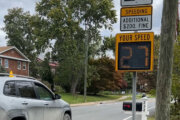Following the Great Recession, housing markets have not had enough supply for buyers throughout the U.S., and it’s frustrating for many first-time homebuyers struggling to keep up with rapidly rising home values.
Fortunately, it looks like some markets are starting to calm down.
While home values continue to climb, they appear to be slowing compared to previous years, and the median listing price is remaining steady — and in some cases dropping.
In May, real estate information company Trulia identified markets in the U.S. where the median home listing price either fell or stalled in March 2018 compared to the same time the year before. Places like Austin, Texas, saw a decrease in median listing price by 3.4 percent, Houston had a mere 0.4 percent increase in median listing price, and Sarasota, Florida, saw just a 0.7 percent increase.
The listing price doesn’t capture the ultimate sale price, but it can be an indicator that markets are finally starting to edge toward the buyer’s benefit. The reasons for decreasing listing prices vary from market to market, but more construction and completion of new homes, additional options outside the city center and a relaxing of the market at high-end prices appears to be easing tensions in some housing markets.
[Read: Why the Best Places to Live May Be in Middle America.]
Here’s a snapshot of three markets where homebuyers may see some relief as they tour houses and condos while searching for their next home.
Sarasota: High-Price Buyers Have Room
Trulia shows slowed increases in listing price, but according to Greg Owens, a local Realtor and president of the Realtor Association of Sarasota and Manatee, the relief is selective. For homes valued less than $500,000, it’s reasonable to expect multiple offers on a property and for it to move quickly.
“Depending on the price range you’re in, you may have to jump a little faster through the hoop,” Owens says.
Properties above the half-million price point, however, are a different story. Homes above $500,000 have more like eight months of inventory on the market, Owens says.
Even with the tough seller’s market in the lower price range, Sarasota is more buyer-friendly than other Florida metro areas. Even as the third fastest-growing metro area in the U.S. due to net migration (between 2012 and 2016, according to the U.S. Census Bureau), home sale price increases have been below the state average increase, Owens says. “That bodes well for our area, for people to come here,” he explains.
The truth is you can get a less expensive home in the Sarasota area as long as you’re willing to sacrifice the luxuries many people move to coastal Florida for. So if you live in the North Point area or east, closer to cattle farms and orange groves rather than the water and beaches, Owens says affordability is far less of a struggle.
“If you don’t mind driving 30 or 40 minutes to the beach, you can find some more affordable housing,” he says.
[Read: 8 Ways to Tell the House You’re Buying Is a Flip.]
Houston: Building Activity Makes Room for More Buyers
According to data from the Houston Association of Realtors, the market had 3.6 months of supply for the month of April (six months of supply is a balanced market), slightly less than a year earlier. While that inventory is inching downward toward a seller’s market, Houston is currently in a balanced market cycle and is also on par with the national average for months of inventory, according to the National Association of Realtors.
Key to Houston’s market, however, is its surging construction activity. In 2017, the Houston metro area saw 42,395 authorized permits for residential construction, according to the U.S. Census Bureau. In the first four months of 2018, 17,417 additional authorizations took place for residential construction.
The metro area’s severe damage from Hurricane Harvey is a primary reason for the spike in construction, but the building activity will likely lead to more movement in the market. Construction is necessary to ensure existing homes that were damaged can be repaired and not undergo further damage over time, as well as build new residences to replace those that can’t be salvaged. But the construction does more than just help replenish what was lost to Hurricane Harvey — a constantly growing metro area with new housing options helps new residents in the area see that the city isn’t held back by the damage it sustained.
But Houston’s building activity is a distant second in terms of Texas metro areas experiencing a construction boom: The Dallas-Fort Worth area saw 22,870 authorized housing units in the first four months of 2018. Trulia’s report points to relaxing median listing prices not just in Houston and Dallas-Fort Worth, but San Antonio and Austin as well.
[Read: 8 Neighborhood Amenities to Look For, Even if You Don’t Use Them.]
Austin: Seek Outside the City Center
The rapidly expanding capital of Texas has been in the midst of a population boom ever since tech companies from Silicon Valley pointed to Austin as a more affordable, easily accessible place to locate new offices following the recession. As a result, Austin has grown by 10.25 percent between 2012 and 2016 due to net migration alone, according to the U.S. Census Bureau.
Because of the interest from relocating professionals, it’s no surprise that the Austin market has been becoming an increasingly tough area for first-time homebuyers. In April, the Austin metro area saw a 5 percent year-over-year increase in median sale price to $315,000, according to the Austin Board of Realtors.
Buyers in the Austin area can still expect tough competition for homes in the hottest city neighborhoods, but don’t give up hope. “There is inventory on the market,” says Jeff Plotkin, a Texas-licensed Realtor, attorney and certified public accountant and vice president of Habitat Hunters Inc. in Austin. “We are resourceful in finding people properties that meet their needs, so long as their pricing expectations and locations are realistic.”
The secret to buying in Austin? Consider buying just outside of Austin. Residential real estate has 2.4 months of inventory on the market in the greater metro area, as opposed to just 1.9 months of inventory inside the city limits. “A lot of people have turned to the suburban areas such as Round Rock, Manor, Buda, Cedar Park because they can get more house for their money,” Plotkin says.
Based on historic housing data from the Real Estate Center at Texas A&M University, the Austin market is coming up on its peak season for available properties, typically running from July to September. The current local inventory implies there will be fewer properties on the market compared to last year, but it’s simply a matter of seeing what becomes available.
Plotkin notes there’s ample construction throughout the area for all types of property, from single-family homes to commercial buildings. More than 9,900 units of housing were authorized for construction in the first four months of 2018, according to the U.S. Census Bureau, with as many as 26,700 authorized in 2017. Austin isn’t building as quickly as Houston or Dallas, but it’s certainly working to provide some relief to all the demand.
More from U.S. News
5 Reasons to Hold Off on Buying a Home Now
How Moving to a New Home Affects Your Taxes
The Homebuying Strategy You Haven’t Heard Of: Going Off-Market
3 Places It May Be Getting Easier to Buy a House originally appeared on usnews.com







